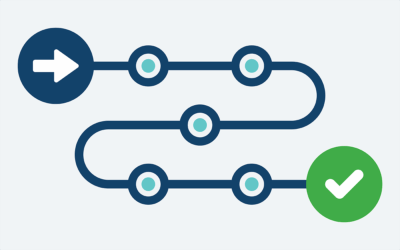B2B buyers are changing, and the skills your sellers need are changing too. If you don’t have a sales enablement strategy to keep your team up to date, you simply won’t be equipped to succeed with today’s buyers.
According to Gartner’s Leadership Vision for 2024 report, 83% of sales leaders report their sellers struggle to adapt to changing customer needs and expectations.
Sales enablement provides a sales team with the information, tools, and resources they need to engage customers and close deals. Sales enablement initiatives help sellers be more efficient, which can lead to shorter sales cycles. The benefits are proven:
- Organizations with a sales enablement strategy achieve a 49% higher win rate on forecasted deals.
- Over the past five years, the sales enablement function has experienced a 343% increase in adoption across companies.
What Is a Sales Enablement Strategy?
A sales enablement strategy is a business’s plan for providing sales teams with the knowledge, tools, and resources they need to sell more effectively. The strategy must be tailored to the specific needs of your sales team to ensure it helps sellers convert leads into customers.
Sales enablement strategies can include:
- Content: Providing sales teams with quality content and ensuring they know which content to use and when.
- Training and coaching: Providing sales teams with training and coaching to help them improve their skills.
- Technology: Using technology to help sales teams learn and practice selling skills more effectively.
- Processes: Ensuring sales teams have the processes they need to sell effectively.
- Reporting and analysis: Tracking sales team performance and measuring results against the bottom line.
- Cross-functional communication: Ensuring there is efficient communication between all customer-facing teams.
- Onboarding: Ensuring new sellers are onboarded quickly and efficiently.
The key to achieving the results you need is to be intentional during the enablement planning process.
Creating a Sales Enablement Strategy: 4 Steps
Follow these steps to plan a sales enablement strategy with the biggest impact on sales performance.
Step 1. Define Sales Enablement for Your Organization
The term “sales enablement” frequently makes its way into conversations around sales productivity and sales performance improvement.
There can be many components to a sales enablement strategy, depending on who you ask and your selling situation. Some experts focus on sales process training and coaching, others on sales enablement software and sales tools, others still on marketing alignment and content strategy.
At its core, sales enablement is a business function that’s designed to help anyone involved in the selling process sell more profitably to prospects and customers.
It’s important to define what sales enablement means to your business based on factors such as:
- Your industry
- Your unique selling environment
- Your business strategy and established sales operations
- The strength and challenge areas you have as an organization
It can often feel overwhelming during the planning process, but getting it right and creating a plan that aligns with your organization’s goals is key.
Step 2. Determine What Your Sales Team Needs to Succeed
To create a sales enablement strategy that works for you, it’s important to identify what will move the mark for your sales team.
Something organizations often skip when developing a sales enablement strategy is actually asking their sales professionals what they need to succeed. Consider polling your sales team members—or sending an anonymous survey—to see what types of tools and training they feel would help them perform better.
In addition, it’s a good idea to understand the characteristics of your top performers. Doing so will allow you to train the rest of your team in those best practices, and also know what to look for in future sales hires.
Interview and/or shadow your A-players to discover:
- What they are saying on calls that’s resonating with prospects
- How they are positioning your product against competitors
- The customer segment they’re seeing the greatest success with
- The strategies they use to move prospects forward in the sales cycle
Step 3. Decide Who Needs to Be Involved
Your sales team doesn’t operate in a silo. To be as successful as possible, they need support from other departments in your organization.
For this reason, it’s important during the planning stage to consider which departments need to be involved in your sales enablement initiative.
Consider the following departments as you create your strategy:
Marketing: Imagine how much more productive your organization would be if your marketing department understood the sales process and could provide materials for every step of the customer journey.
Keeping your sales and marketing departments aligned and in agreement on your target audience will exponentially improve your overall efficiency and sales effectiveness.
Customer service: In today’s crowded marketplace, a positive customer experience can go a long way toward differentiating your company from the competition.
In addition, your customer service team is in a position to uncover revenue opportunities and turn one-time customers into repeat buyers. Aligning customer success and sales can unlock a wealth of benefits. But without the proper training and alignment, they are likely leaving money on the table.
Account management: Whether you have a dedicated team of account managers or your sales professionals oversee their own accounts, it’s important to provide the strategic account management training and tools to prioritize key accounts and maintain profitable, long-term customer relationships.
When you’re creating your sales enablement strategy, make sure you also have non-sales departments trained in your sales process and empowered with a sales-focus mindset. Doing so will ensure that everyone is working together toward the common goal of increased sales.
Step 4. Deploy the Strategy and Reinforce New Habits
Once you’ve created your action plan and identified where opportunities for cross-functional collaboration exist, it’s time to deploy your sales enablement strategy.
In over 40 years in the industry, we’ve learned that the ROI for a sales enablement initiative is greatest when it’s followed up by a strategic reinforcement program.
Remember to use refreshers and coaching to reinforce any training you deliver, and continually check in to see where you can be optimizing—using metrics, surveys, and other ROI tools.
Give Your Sales Enablement Initiatives the Best Chance to Succeed
Sales enablement often involves changing or improving the processes and established culture that exist in your organization. We’re all too familiar with the saying, “If you fail to plan, you are planning to fail.”
As with any other change management initiative, sales enablement should be properly planned out to ensure the desired outcomes are met. Give your sales enablement strategy the best chance for success by carefully and intentionally mapping out the execution plan before beginning any work.
You can do this on your own, but we suggest working with an experienced sales training program provider who’s familiar with the most common mistakes, pitfalls, and keys to getting your plan off the ground and running. Contact The Brooks Group’s sales training experts to get started.




